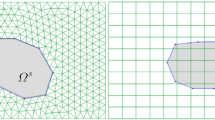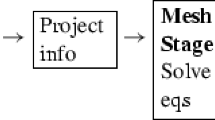Abstract
This work proposes a fully Lagrangian formulation for the numerical modeling of free-surface particle-laden flows. The fluid phase is solved using the particle finite element method (PFEM), while the solid particles embedded in the fluid are modeled with the discrete element method (DEM). The coupling between the implicit PFEM and the explicit DEM is performed through a sub-stepping staggered scheme. This work only considers suspended spherical particles that are assumed not to affect the fluid motion. Several tests are presented to validate the formulation. The PFEM–DEM results show very good agreement with analytical solutions, laboratory tests and numerical results from alternative numerical methods.























Similar content being viewed by others
References
Alobaid F (2015) A particle-grid method for Euler-Lagrange approach. Powder Technol 286:342–360
Aly AM, Asai M (2018) Water entry of decelerating spheres simulations using improved ISPH method. J Hydrodyn 30(6):1120–1133
Anderson TB, Jackson R (1967) Fluid mechanical description of fluidized beds. Equations of motion. Ind Eng Chem Fundam 6(4):527–539
Bec J (2003) Fractal clustering of inertial particles in random flows. Phys Fluids 15(11):L81–L84
Beetstra R, van der Hoef MA, Kuipers JAM (2007) Drag force of intermediate Reynolds number flow past mono-and bidisperse arrays of spheres. AIChE J 53(2):489–501
Brezzi F (1974) On the existence, uniqueness and approximation of saddle-point problems arising from Lagrange multipliers. Revue française d’automatique, informatique, recherche opérationnelle Série rouge. Analyse numérique 8(R—-2):129–151
Casas G (2018) Numerical analysis of particle-laden flows with the finite element method. Doctoral Thesis, Polytechnic University of Catalonia, Barcelona
Casas G, Mukherjee D, Celigueta MA, Zohdi TI, Onate E (2017) A modular, partitioned, discrete element framework for industrial grain distribution systems with rotating machinery. Comput Particle Mech 4(2):181–198
Celigueta MA, Deshpande KM, Latorre S, Oñate E (2016) A FEM-DEM technique for studying the motion of particles in non-Newtonian fluids. Application to the transport of drill cuttings in wellbores. Comput Particle Mech 3(2):263–276
Cerquaglia ML, Deliège G, Boman R, Terrapon V, Ponthot JP (2016) Free-slip boundary conditions for simulating free-surface incompressible flows through the particle finite element method. Int J Numer Methods Eng 110(10):921–946
Cervantes AM, Hidalgo S, Pacheco F (2018) The simultaneous discharge of liquid and grains from silo. Phys Fluids 30:043302
Deen NG, Peters EAJF, Padding JT, Kuipers JAM (2014) Review of direct numerical simulation of fluid-particle mass, momentum and heat transfer in dense gas-solid flows. Chem Eng Sci 116:710–724
De Pouplana I, Oñate E (2017) A FIC-based stabilized mixed finite element method with equal order interpolation for solid-pore fluid interaction problems. Int J Numer Anal Methods Geomech 41:110–134
Ding WT, Xu WJ (2018) Study on the multiphase fluid-solid interaction in granular materials based on an LBM-DEM coupled method. Powder Technol 335:301–314
Drew DA, Passman SL (1999) Theory of multicomponent fluids. Springer, New York
Edelsbrunner H, Mucke EP (1999) Three dimensional alpha shapes. ACM Trans Graph 13:43–72
Edelsbrunner H, Tan TS (1993) An upper bound for conforming Delaunay triangulations. Discrete Comput Geom 10(2):197–213
Elghobashi S (1994) On predicting particle-laden turbulent flows. Appl Sci Res 52(4):309–329
Epelle E, Gerogiorgis DI (2018) CFD modelling and simulation of drill cuttings transport efficiency in annular bends: effect of particle sphericity. J Pet Sci Eng 170:992–1004
Franci A, Cremonesi M (2017) On the effect of standard PFEM remeshing on volume conservation in free-surface fluid flow problems. Comput Particle Mech 4(3):331–343
Franci A, Cremonesi M (2019) 3D regularized \(^{1}\)(I)-rheology for granular flows simulation. J Comput Phys 378:257–277
Franci A, Oñate E, Carbonell JM (2015) On the effect of the bulk tangent matrix in partitioned solution schemes for nearly incompressible fluids. Int J Numer Methods Eng 102(3–4):257–277
Fullmer WD, Liu G, Yin X, Hrenya CM (2017) Clustering instabilities in sedimenting fluid-solid systems: critical assessment of kinetic-theory-based predictions using direct numerical simulation data. J Fluid Mech 823:433–469
Gui N, JianRen F, Kefa C (2008) Effect of particle-particle collision in decaying homogeneous and isotropic turbulence. Phys Rev E 78(4):046307
Hairer E, Lubich C, Wanner G (2003) Geometric numerical integration illustrated by the Störmer-Verlet method. Acta Numer 12:399–450
He Y, Bayly AE, Hassanpour A, Muller F, Wu K, Yang D (2018) A GPU-based coupled SPH-DEM method for particle-fluid flow with free surfaces. Powder Technol 338:548–562
Hirt CW, Nichols BD (1981) Volume of fluid (VOF) method for the dynamics of free boundaries. J Comput Phys 39:201–225
Hu C, Sueyoshi M (2010) Numerical simulation and experiment on dam break problem. J Mar Sci Appl 9(2):109–114
Idelsohn SR, Calvo N, Oñate E (2003) Polyhedrization of an arbitrary point set. Comput Methods Appl Mech Eng 92(22–24):2649–2668
Idelsohn SR, Oñate E, Del Pin F (2004) The particle finite element method: a powerful tool to solve incompressible flows with free surfaces and breaking waves. Int J Numer Methods Eng 61:964–989
Idelsohn SR, Marti J, Limache A, Oñate E (2008) Unified Lagrangian formulation for elastic solids and incompressible fluids: applications to fluid-structure interaction problems via the PFEM. Comput Methods Appl Mech Eng 197:1762–1776
Ireland PJ, Desjardins O (2017) Improving particle drag predictions in Euler-Lagrange simulations with two-way coupling. J Comput Phys 338:405–430
Kawaguchi T, Tanaka T, Tsuji Y (1998) Numerical simulation of two-dimensional fluidized beds using the discrete element method (comparison between the two-and three-dimensional models). Powder Technol 96(2):129–138
Kendoush AA (2007) The virtual mass of an oblate-ellipsoidal bubble. Phys Lett A 366(3):253–255
Kidanemariam AG, Chan-Braun C, Doychev T, Uhlmann M (2013) Direct numerical simulation of horizontal open channel flow with finite-size, heavy particles at low solid volume fraction. New J Phys 15(2):025031
Koshizuka S, Oka Y (1996) Moving-particle semi-implicit method for fragmentation of incompressible fluid. Philos Nucl Sci Eng 23(3):421–434
Koshizuka S, Oka Y (2000) Moving particle semi-implicit method: fully Lagrangian analysis of incompressible flows. In: Proceedings of the European Congress on computational methods in applied sciences and engineering (ECCOMAS), Barcelona, Spain
Lain S, Sommerfeld M (2003) Turbulence modulation in dispersed two-phase flow laden with solids from a Lagrangian perspective. Int J Heat Fluid Flow 24(4):616–625
Larese A, Rossi R, Oñate E, Idelsohn SR (2008) Validation of the particle finite element method (PFEM) for simulation of free surface flows. Int J Comput Aided Eng Softw 25:385–425
Loth E (2008) Drag of non-spherical solid particles of regular and irregular shape. Powder Technol 182(3):342–353
Loth E, Dorgan AJ (2009) An equation of motion for particles of finite Reynolds number and size. Environ Fluid Mech 9(2):187–206
Martin JC, Moyce WJ (1952) An experimental study of the collapse of liquid columns on a rigid horizontal plane 4. Philos Trans R Soc Lond Ser A 244:312–324
Mckeen T, Pugsley T (2003) Simulation and experimental validation of a freely bubbling bed of FCC catalyst. Powder Technol 129(1–3):139–152
Meduri S, Cremonesi M, Perego U, Bettinotti O, Kurkchubasche A, Oancea VM (2018) A partitioned fully explicit Lagrangian finite element method for highly nonlinear fluid-structure interaction problems. Int J Numer Methods Eng 113:43–64
Meduri S, Cremonesi M, Perego U (2018) An efficient runtime mesh smoothing technique for 3D explicit Lagrangian free-surface fluid flow simulations. Int J Numer Methods Eng 113:43–64
Monforte L, Arroyo M, Carbonell JM, Gens A (2018) Coupled effective stress analysis of insertion problems in geotechnics with the particle finite element method. Comput Geotech 101:114–129
Norouzi HR, Zarghami R, Sotudeh-Gharebagh R, Mostoufi N (2016) Coupled CFD-DEM modeling: formulation, implementation and application to multiphase flows. Wiley, Hoboken
Oñate E (1998) Derivation of stabilized equations for advective-diffusive transport and fluid flow problems. Comput Methods Appl Mech Eng 151:233–267
Oñate E, Idelsohn SR, Del Pin F, Aubry R (2004) The particle finite element method–an overview. Int J Comput Methods 1:267–307
Oñate E, Celigueta MA, Idelsohn SR (2006) Modeling bed erosion in free surface flows by the particle finite element method. Acta Geotech 1(4):237–252
Oñate E, Celigueta MA, Latorre S, Casas G, Rossi R, Rojek J (2014) Lagrangian analysis of multiscale particulate flowswith the particle finite element method. Comput Particle Mech 1(1):85–102
Oñate E, Franci A, Carbonell JM (2014) Lagrangian formulation for finite element analysis of quasi-incompressible fluids with reduced mass losses. Int J NumerMethods Fluids 74(10):699–731
Radl S, Sundaresan S (2014) A drag model for filtered Euler-Lagrange simulations of clustered gas-particle suspensions. Chem Eng Sci 117:416–425
Radl S, Girardi M, Sundaresan S (2012) Effective drag law for parcel-based approaches-what can we learn from CFD-DEM? In: ECCOMAS (2012)
Robinson M, Ramaioli M, Luding S (2014) Fluid-particle flow simulations using two-way-coupled mesoscale SPH-DEM and validation. Int J Multiph Flow 59:121–134
Ryzhakov P, Oñate E, Idelsohn SR (2012) Improving mass conservation in simulation of incompressible flows. Int J Numer Methods Eng 90:1435–1451
Shiller L, Naumann A (1935) A drag coefficient correlation. Zeitschrift des Vereins Deutscher Ingenieure 77:318–320
Snider DM (2001) An incompressible three-dimensional multi-phase particle-in-cell model for dense particle flows. J Comput Phys 170(2):523–549
Sun X, Sakai M, Yamada Y (2013) Three-dimensional simulation of a solid-liquid flow by the DEM-SPH method. J Comput Phys 248:147–176
Thornton C, Cummins SJ, Cleary PW (2011) An investigation of the comparative behaviour of alternative contact force models during elastic collisions. Powder Technol 210(3):189–197
Vermorel O, Bedat B, Simonin O, Poinsot T (2003) Numerical study and modelling of turbulence modulation in a particle laden slab flow. J Turbul 4(25):1–39
Wakaba L, Balachandar S (2007) On the added mass force at finite Reynolds and acceleration numbers. Theor Comput Fluid Dyn 21(2):147–153
Williams JR, Perkins E, Cook B (2004) A contact algorithm for partitioning N arbitrary sized objects. Eng Comput 21(2/3/4):235–248
Zhang X, Krabbenhoft K, Pedroso DM, Lyamin AV, Sheng D, Vicente da Silva M, Wang D (2013) Particle finite element analysis of large deformation and granular flow problems. Comput Geotech 54:133–142
Zhou ZY, Kuang SB, Chu KW, Yu AB (2010) Discrete particle simulation of particle-fluid flow: model formulations and their applicability. J Fluid Mech 661:482–510
Zhu M, Scott MH (2014) Modeling fluid-structure interaction by the particle finite element method in OpenSees. Comput Struct 132:12–21
Acknowledgements
The first author, beneficiary of an AXA Research Fund post-doctoral grant (Grant Number 2017-AXA-PDOC1-099), acknowledges the company for its economic support.
Author information
Authors and Affiliations
Corresponding author
Additional information
Publisher's Note
Springer Nature remains neutral with regard to jurisdictional claims in published maps and institutional affiliations.
Appendix
Appendix
All vectors and matrices introduced in Sect. 3 are listed below. The variables used in the following refer to the fluid domain, hence the subindex f is here omitted (e.g. \(\rho ={\rho }_f\)).
The fully-discretized form of the linear momentum equations (Eq. (1)) reads
where \(\varvec{K}\) is computed as the sum of stiffness and mass matrices as
with
and \(\varvec{R}\) is the residual of the discretized linear momentum equations computed at each iteration i as
where \( N_I\) are the linear shape functions and, for a 3D problem, \(\varvec{B}\) and \(\varvec{c}\) are defined as follows
The fully-discretized form of the continuity equation (Eq. (4)) reads
where
with
where \(\varGamma _t\) is the free-surface contour and the stabilization parameter \(\tau \) is defined as
where h and \( \delta \) are characteristic distances in space and time [52].
Finally,
where in 3D \( \mathbf{m } = [1,1,1,0,0,0]^T\).
Details on the derivation of above matrices and vectors can be found in [52].
Rights and permissions
About this article
Cite this article
Franci, A., de-Pouplana, I., Casas, G. et al. PFEM–DEM for particle-laden flows with free surface. Comp. Part. Mech. 7, 101–120 (2020). https://doi.org/10.1007/s40571-019-00244-1
Received:
Revised:
Accepted:
Published:
Issue Date:
DOI: https://doi.org/10.1007/s40571-019-00244-1




